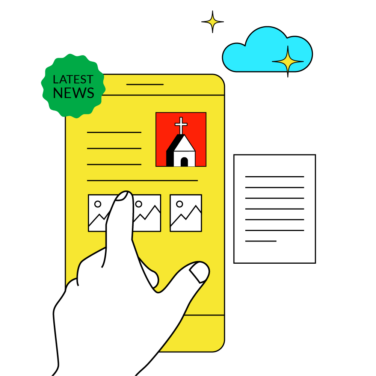In the nascent days of the early church, spreading the word was a natural process, guided by the divine and shared orally, much like stories from the Bible.
Today, as society has transformed, so too has the approach to church marketing, necessitating a blend of the biblical tenets of community with innovative strategies. To thrive, churches must craft a comprehensive church marketing plan that resonates with both their local community and the digital landscape.
This guide will outline pivotal church marketing ideas that intertwine the timeless with the contemporary, from organizing community events or creative church fundraisers that celebrate occasions like Christmas to harnessing digital platforms for broader nonprofit outreach. By integrating these elements into your church events, you establish a solid foundation to connect, engage, and grow your congregation. These insights come from hard lessons I learned in my time as a leader in a church in Los Angeles to help you avoid similar mistakes when it comes to keeping your church population steadfast.
I'll cover:
- The Evolution of Church Marketing: from Past to Present
- 8 Church Marketing Strategies To Grow And Sustain Your Church + best practices
- Why Churches Need Marketing
- Church Member Retainment Best Practices
- Embracing Change for Congregation Growth
The Evolution of Church Marketing: from Past to Present
The trajectory of church marketing has transitioned from the organic spread through word-of-mouth in its nascent days to the strategic use of digital platforms.
This shift reflects broader changes in communication and community engagement. Identifying pivotal developments in this evolution gives insight into how churches can integrate traditional approaches with contemporary digital strategies to foster growth and maintain relevance in a rapidly changing landscape.
- Preaching and word-of-mouth were the foundational marketing strategies for ancient religious communities
- Digital marketing's rise has allowed churches to reach broader and more diverse audiences
- Declining church membership among millennials highlighted the need for modern marketing techniques
We need to think about where we came from to inform where we need to go, drawing on the past to navigate the future of church outreach.
8 Church Marketing Strategies To Grow And Sustain Your Church
Before exploring the eight church marketing strategies, understand that growth isn't solely about numbers. A small congregation holds as much value as a large one.True growth occurs in various ways:
- through increasing membership
- and deepening the faith of existing members.
Both are crucial. Here are the eight digital marketing strategies aimed at achieving these growth dimensions.
1. Create A Modern Website For Your Church
Establishing your church's identity is essential. While our ultimate identity is in Christ, outwardly, it's about shaping how others perceive your church. Begin with outlining your church’s core beliefs and perspectives.
Armed with clarity on your church's identity, proceed to craft a modern digital presence, starting with a dynamic website – your church's virtual front door. When developing your site, there are a million directions you could go (exploring Google's Ad Grant for churches being one). I recommend you either collaborate with a professional agency or opt for a church website builder. Don't skimp on this; it's an investment in your church's online image.
Take cues from well-executed examples:
- Angelus Temple showcases a minimalist yet impactful design. (I used to work here)
- Elevation Church offers a design that's vibrant but not overpowering.
Ensure your church website meets these key objectives:
- Present information clearly and concisely.
- Maintain an uncluttered layout to avoid overwhelming visitors.
- Optimize for mobile devices to cater to the majority of your online visitors.
By focusing on these elements, your church's website will effectively communicate its message and invite engagement from both potential and current members. Learn more about how to create a church website here.
SEO Best Practices for Church Websites:
Incorporating SEO best practices is crucial for a church website looking to attract new visitors and serve its local church community effectively. Here's how to leverage SEO for your church:
- Optimize Your Homepage:
- Ensure your homepage clearly communicates your church's mission and values, utilizing relevant keywords.
- Highlight Upcoming Events:
- Feature upcoming events prominently with detailed descriptions and keywords that local community members are likely to search for.
- Make Contact Information Accessible:
- Display your phone number and address on every page to improve local search rankings and make it easy for new visitors to contact or find you.
- Use Search Engine Optimization Strategically:
- Treat SEO as a powerful tool, integrating it into your content creation process to increase visibility and draw more traffic to your website.
By implementing these SEO best practices, your church website can serve as a beacon, guiding new visitors to your community and keeping your congregation informed and engaged.
2. Social Media Focus
Social media is crucial in shaping your church's public persona and engaging with the congregation both old and new. It's not about personal preference; it's about reaching where the people are. Here's how to leverage social media platforms effectively:
I also understand that some pastors do not like social media or even use it themselves. At the end of the day, though, this is not a question of your personal preferences or not. If you’re content with sticking to the church growth and size that you currently have, that’s fine.
Social media Strategy framework for churches
| Social Media Platform | Purpose for Church Marketing | Example Communication for the platform | Posting Frequency suggestion | Audience |
|---|---|---|---|---|
| Announcements, events, community building | "Join us for our annual picnic this Sunday!" | Daily | Broad, 24+ demographics, families | |
| Quick updates, scripture sharing, real-time engagement | "Reflect on today's sermon: 'Faith is taking the first step...'" | Multiple times a day | Young adults, influencers, information seekers | |
| Visual storytelling, events, behind-the-scenes | Weekly photo series of community outreach | 1-2 times per day | Teens, young adults, visual-oriented users | |
| Twitch | Livestreaming services, interactive studies | "Live now: Join our Bible study group!" | During live events or services | Gamers, younger demographics, interactive users |
| YouTube | Sermon archives, music, testimonial videos | "This week's sermon is now available online." | 1-2 times per week | Broad audience, video consumers, educational seekers |
| TikTok | Engaging younger demographics, inspirational messages | 15-second clip sharing a message of hope | 3-5 times per week | Gen Z, young millennials, trend followers |
Best practices for maximizing social media for church growth
- You pastors with a strong digital ministry profile, you understand the importance of appointing a dedicated social media manager or team to maintain a consistent online presence.
- For Facebook and Twitter, tailor your content to inform and invite community interaction.
- Transform Instagram into a visual narrative of your church's activities and milestones.
- Use Twitch and YouTube for reaching those who prefer digital attendance, providing them a taste of your services before they join in person.
- Embrace TikTok to connect with the next generation through creative, short-form content.
3. Cohesive Branding
Creating a distinct church brand image is not merely a business tactic; it’s a powerful way to establish your church's presence and mission in the community. Though the church is not a business, branding can still apply here. Here’s how to build and utilize your church’s brand effectively:
- Identify Your Church’s Brand Elements:
- Choose a meaningful logo that represents your church's spirit (or create a logo from scratch).
- Select a tagline or verse that encapsulates your church’s message.
- Decide on a set of colors that will be synonymous with your church.
- Implement Your Brand Across All Channels:
- Consistently use your branding on your website and social media pages.
- Display your brand on physical items like church signs, apparel, and vehicles.
- Ensure that your branding is prominent at events and community booths.
The Positive Impact of Cohesive Branding:
- Community Recognition: A strong brand makes your church instantly identifiable in the community and beyond.
- Appeal to Newcomers: A professional and unified brand image can be more inviting to those looking to join a church.
- Member Retention: Consistent branding fosters a sense of unity and belonging among existing members.
This cohesive branding will ensure that your church spreads in the community, and possibly the world, as a recognizable organization. This will not only make you more appealing to newcomers wanting to check out your church but it will create a unified church body. This can help with retaining existing members, too, since they feel part of the same unit.
4. Define Your Environment
With the more boring, administrative parts of marketing out of the way, we can get to the exciting stuff. The point of marketing your church is to get out there and do something to bring in your target audience. To be able to do this, you need to first define the environment that is surrounding the four walls of your place of worship.
Every church has a different community and needs to be handled in its own unique way, too. Are you in a small town? Or maybe you are in the suburbs next to a highly populated city. For some churches, the location can affect the concerns in your area as well. For instance, one town might deal with a lot of violent crime while another struggles with an overwhelming number of people with substance use disorders.
How to identify your target market and their needs
Here's a basic framework for how to tailor your church marketing to the community's fabric:
- Assess the Community Context:
- Understand the unique character of your community, whether it's a quaint town or a bustling suburb.
- Recognize local concerns, like crime rates or public health issues, which can shape community needs.
- Customized Community Engagement:
- Leverage your insider knowledge to identify and address the specific needs of your congregation and community.
- Develop targeted initiatives that resonate with local interests and concerns.
By intimately knowing your community, you can craft church marketing initiatives that are not just general calls to action, but specific invitations to a church that understands and caters to its people's needs. This approach not only demonstrates empathy but also positions your church as an integral part of the local landscape, invested in the community's well-being.
5. Community Outreach
Community outreach is pivotal in church marketing and growth. When church leaders inquire about increasing their congregation, the first suggestion is often to evaluate their engagement in community outreach events. These events are not just a directive of faith but also an effective means to connect with potential new members.
How to leverage outreach in your marketing strategy:
- Conduct Needs Assessment:
- Identify pressing needs within your community, such as food scarcity or after-school programs.
- Initiate Outreach Programs:
- Implement programs that address these needs directly, like daily food giveaways linked to children's outreach initiatives.
- Communicate and Expand:
- Promote these programs to your community, highlighting the support you provide.
- Use the growth of these programs to invite families to further engage with your church.
- Build Community Relations:
- As your church becomes known for its outreach, it solidifies its reputation as a caring and active community member, attracting support and new congregants.
By aligning your church's outreach efforts with the specific needs of your surroundings, you'll not only serve your community but also grow your congregation organically and sustainably.
6. Practice sustainable marketing growth
Practicing sustainable marketing growth is essential for churches to avoid the pitfalls of overextension. It's not uncommon for churches, driven by zeal, to attempt to meet every need, which can lead to burnout and a loss of focus.
How to ensure sustainable growth in your church marketing:
- Acknowledge Limitations:
- Recognize and accept the practical limitations of your church's resources.
- Develop a Phased Plan:
- Start with small, manageable outreach initiatives that impact your immediate neighborhood.
- Gradually expand your reach to the town, the city, and beyond as your capacity allows.
- Seek Divine Guidance:
- Continuously seek God’s guidance to complement your earthly efforts with divine support.
- Control Marketing Efforts:
- Market your church thoughtfully to ensure the message aligns with your mission.
- Avoid unchecked expansion that could negatively affect your church’s reputation.
By following a measured and phased approach, your church can grow its presence and influence without compromising its core values or the well-being of its community and members.
7. Retaining existing members
I will try to tread lightly here but there are some churches in the past that I was involved in (not the one in Los Angeles) that made a huge mistake. They were fantastic about outreach and bringing in tons of new church members but completely failed the existing members of the congregation.
It was a tragic and devastating cycle of bringing in literally hundreds of new people and seeing them on fire only for it to burn out rather quickly. But, instead of helping them in their ongoing walks, they were forgotten and set aside in favor of continuing to bring in new people. So, it was an endless cycle of new people joining, old people leaving, and so on.
Retaining existing church members is as important as attracting new ones. Churches often excel at outreach but overlook the needs of their current congregation, leading to a cycle of high turnover.
Here's how to maintain a balance:
- Focus on Member Experience:
- Ensure that church initiatives cater to the spiritual growth and community needs of existing members.
- Nurture Spiritual Development:
- Provide diverse programs that support long-term faith journeys, not just initial conversion experiences.
- Foster Community Ties:
- Encourage and facilitate relationship-building within the congregation to strengthen communal bonds.
- Continual Engagement:
- Regularly seek feedback and adapt church activities to keep pace with members' evolving needs.
By prioritizing the well-being and spiritual nourishment of current members, your church can create a stable and welcoming environment that encourages long-term engagement.
8. Create a Dedicated Congregation Development Team
To help with existing churchgoers, I recommend establishing a dedicated congregation development team or system. Promote a path that is all about a person’s journey at the church. It should not start and end with them coming to your services for the first time. What I recommend is to first have a loving and open welcome to the church for everyone who enters.
From there, offer program(s) that teach the newcomers everything about your church and being a new believer, if applicable. Many churches do these first two steps but nothing else afterward. Small groups are a decent and common option after this, plugging someone into a group of like-minded people who perhaps have similar interests and hobbies.
Establishing a dedicated Congregation Development Team is a strategic approach to nurturing both new and existing church members. This team focuses on creating a welcoming environment and provides a structured journey for spiritual and community growth.
Here’s how to implement this effectively:
- Welcome and Integration:
- Start with a heartfelt welcome for all newcomers, setting the tone for their journey within the church.
- Newcomer Orientation Programs:
- Offer comprehensive programs that introduce new members to church life and, if they are new believers, to foundational Christian teachings.
- Diverse Participation Avenues:
- Beyond small groups, provide opportunities for members to engage with various ministries according to their interests, such as children’s church, youth groups, outreach, and tech teams.
- Pathway for Engagement:
- Outline clear steps for members to get involved and advance in their church involvement. Announce exciting trips and enjoyable outings with one another so that there is lots for people to get involved in besides just the church services.
- Community Building Events:
- Plan and promote engaging activities and trips that foster strong bonds outside regular services.
- Resource Allocation:
- Ensure the Congregation Development Team has a dedicated budget to execute these initiatives effectively.
A team that carefully plans out these events and how and when to promote and develop their church budget can ensure that not just the new members feel loved and cared for. This is how you gain and sustain growth in your church community.
More Articles
- 11 Step Church Security Checklist To Keep Your Church Safe
- Youth Ministry Curriculum Guide: How To Choose The Best One
- Youth Ministry Guide: 7 Key Components & How To Build
Do Churches Need Marketing?
Many churches, especially those that were established long before the advent of the internet, do not see the importance of marketing. But I will stand by that every single church leader in the present day needs a digital marketing strategy of some kind. Not every church needs an entire team dedicated to it, but at least something or someone.
Marketing is essential for churches in the digital era, regardless of their size or history. Here's why:
- Digital Presence: A digital marketing strategy is crucial for churches to stay relevant and visible, especially to younger generations.
- Engagement Beyond Physical Boundaries: Even a small church in a remote area can extend its reach and provide guidance and inspiration through effective online marketing.
- Adaptation to Current Times: Churches that do not embrace modern marketing approaches risk losing connection with potential new members, particularly the younger demographic.
- Evangelism and Outreach: Marketing can be seen as a contemporary form of evangelism, helping to spread the church’s message and reach those in need of spiritual support.
- Sustainability: In a world where online presence can dictate organizational longevity, marketing is not optional but a necessity for churches to thrive and continue their mission.
There are so many people who need Jesus Christ today and a church needs some form of marketing to reach them using adequate church communication. In sum, marketing is not just about growth—it's about connection and relevance in a rapidly changing world. Churches need to embrace marketing to fulfill their mission in the modern context.
Church Member Retainment Best Practices
There is a lot of information that I provided in this guide and I get that it can be a tad overwhelming at first. This is doubly the case if someone is newer to dealing with marketing tools like live-streaming and building out a website. Fortunately, we have some other guides to help with those next steps in expanding and retaining your church members. R
- Begin with Education:
- Familiarize yourself with church marketing basics through comprehensive guides available on the topic.
- Invest in Digital Tools:
- Explore and implement the best streaming software to connect with members unable to attend in person. Check out the nine best streaming software that you can use to ensure that you can bring in new members who might not be ready to attend your services in-person just yet
- Website Optimization:
- Utilize expert resources to develop a church website that's both engaging and easy to navigate.
- Continuous Learning:
- Stay informed and adapt by reading up on the latest church growth strategies and marketing trends.
- Seek Expertise:
- Don’t hesitate to consult detailed guides by marketing professionals for specific areas like website building
Embracing Change for Congregation Growth
Embracing the dynamic landscape of church marketing is pivotal for growth and community engagement. The strategies outlined offer a roadmap for expanding your reach and deepening connections within your congregation. The digital age presents myriad opportunities for churches to communicate their message and mission effectively. As you continue to adapt and refine your approach, staying updated on the latest trends and best practices is invaluable.
To stay at the forefront of church marketing innovation, sign up for our newsletter. You’ll receive regular updates, expert tips, and thoughtful insights directly to your inbox, empowering you to lead your church with vision and purpose




